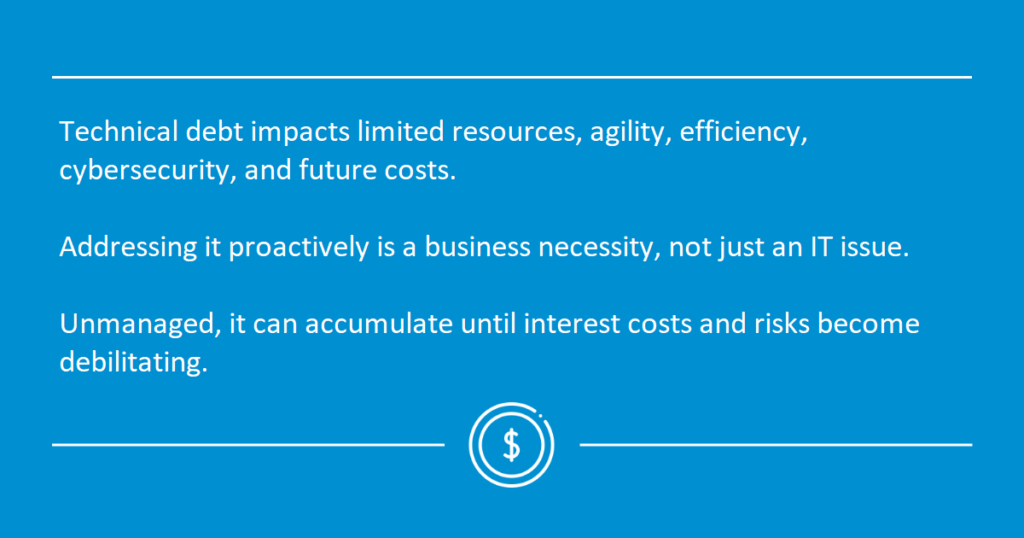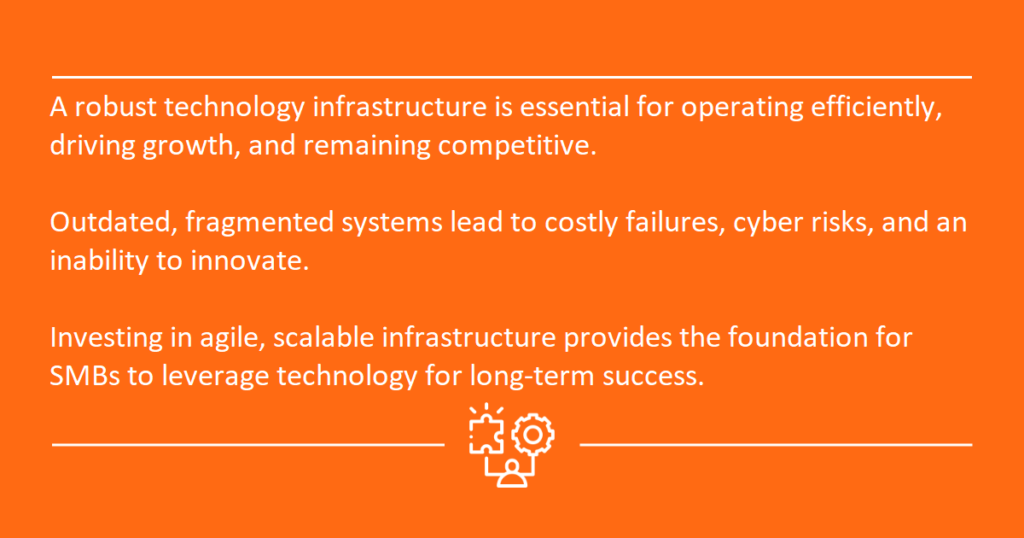
As a CEO, you rely on technology more than ever to drive efficiency and innovation. But lurking within your IT infrastructure threatens those goals is technical debt.
Technical debt slowly and stealthily undermines your organization’s agility. Legacy systems, outdated platforms, and institutional knowledge all accrue interest in the form of maintenance costs and put a drag on productivity.
Left unmanaged, technical debt can accumulate until a breaking point…
In this quick conversation, we will reexamine the concept of technical debt and outline steps you can take to monitor, quantify, and address it through focused paydown initiatives.
You’ll learn how to build technical leadership and communicate technology investments in clear business terms.
You can transform this threat into a strategic advantage with a proper budget and roadmap to tackle technical debt. Your systems will become more resilient, your teams more productive, and your organization better positioned to innovate.
Let’s get started.

At its heart, “technical debt” is a term borrowed from the financial world, and it’s used to describe shortcuts or compromises made during the development or updating of software and IT systems.
Just as financial debt comes with interest that accumulates over time, technical debt accrues its own “interest” in the form of…
In other words, it’s the technical equivalent of financial debt. Taking on debt gives you immediate resources, but you incur interest charges in the future.
With technical debt, you get faster results upfront, but you pay interest in the form of extra maintenance work down the road.

Unlike larger corporations with vast IT departments and budgets, small to midsized organizations often operate with constrained resources. Any inefficiencies or additional work arising from technical debt can strain these resources even further.
Smaller organizations often pride themselves on being agile and being able to pivot or adapt to market changes quickly. However, technical debt can act like an anchor, slowing down this agility, especially when integrating new technologies or scaling operations.
In today’s digital age, most operations, even for smaller firms, rely heavily on technology. Outdated systems or software resulting from unresolved technical debt can hamper day-to-day activities, leading to frustrated employees and dissatisfied customers.
One common form of technical debt is not updating software or systems. This can leave organizations vulnerable to cyberattacks, a risk that no business, regardless of size, can afford to take.
As unpaid financial debt grows over time, the longer technical debt remains unresolved, the costlier it becomes. What might have been a simple fix initially can evolve into a complex and expensive problem.
In essence, technical debt isn’t just a tech term for small to mid-sized organizations. It’s a business consideration. Addressing it proactively can mean the difference between smooth operations and a tangled web of IT problems.
This debt manifests as time and resources your teams must dedicate to “paying interest” – costly upkeep of outdated solutions. It also hinders agility and innovation.
A small technical debt, like financial debt, may be acceptable if managed properly. But unchecked debt accumulates until interest payments become debilitating.

Legacy systems and past shortcuts eventually require interest payments in the form of extra maintenance workarounds and a high risk of failure. This debt drag on resources only grows over time.
Technical debt prioritizes immediate gains over sustainable innovation. The quick win today leads to ongoing interest payments that hinder agility down the road.
If you only make the minimum payments on technical debt, it will accumulate and impact agility and innovation. You end up dedicating more and more resources to maintaining brittle legacy systems.
Some common root causes of technical debt include:
Like clutter accumulating in a house over time, technical debt piles up until a massive clean-up effort is required. It’s better to address it incrementally.
Ignoring technical debt is like ignoring credit card debt. It seems harmless at first, but eventually, interest payments exceed your ability to pay.
Without diligent monitoring and servicing of technical debt, it can accumulate to the point of “technical bankruptcy” – systems reach such fragility that failure and disaster occur.
Proactive management keeps your debt at a reasonable level through incremental paydown efforts. This maintains your agility and resilience.
On the surface, technical debt seems harmless. But in reality, it has crippling effects if left unmanaged. Here’s why it deserves more urgent attention:
Often, when businesses take stock of their challenges, technical debt might not top the list. But its quiet, lurking presence can be one of the most substantial drags on an organization’s growth and agility. Understanding the depth and breadth of this concern is vital for anyone in a leadership role.
Technical debt is like cholesterol buildup in your IT infrastructure – it makes things sluggish, rigid, and unable to adapt. Paying down debt improves organizational agility.
The “interest payments” on technical debt sap resources that could be used for innovation. This extra maintenance work adds up exponentially over time.
Systems burdened with technical debt are fragile. This increases the risks of:
Unlike financial debt, technical debt won’t disappear if you ignore it. It must be actively monitored and managed or accumulate to dangerous levels.
Technical debt is like the defectively designed foundation of a building. It seems fine at first but leads to expensive disasters down the road.
View technical debt paydown initiatives as investments in future resilience and innovation, not a cost. Allocate resources specifically to tackle debt.
Paying technical debt is like losing weight – your systems become more agile and able to take advantage of new opportunities.

It’s akin to spotting a leak in a boat and choosing not to fix it, hoping the problem will resolve itself. Active monitoring and management are the orders of the day.
It’s about being in the driver’s seat, steering your organization away from potential pitfalls, rather than being a passenger, watching challenges amplify.
Technical debt might not scream for attention in the vast business challenges landscape.
But its silent impact is profound. Addressing it doesn’t just solve IT issues; it positions an organization for growth, resilience, and future success. After all, the most forward-thinking leaders know that being proactive in IT and technology isn’t a cost—it’s an investment in the organization’s future.
Before tackling technical debt, you need to identify and quantify it. Here are some steps:
Technical debt might be an intangible problem, but leaves very tangible tracks. It’s like a slow leak in a tire; you might not see it, but you’ll feel its effects.
Frequent system glitches, unusually slow applications, and a consistent need for workarounds are clear indicators. If your team often relies on ‘tribal knowledge’ – unwritten procedures known only to a few – you’re likely grappling with technical debt.
These “interest payments” indicate debt that needs addressing.
Consider the criticality of each system in your organization. Which are mission-critical? Which strategies, if they went offline for a day, would cripple your operations?
The more central a system is to your business, the higher the stakes. But even peripheral systems, if outdated, can create inefficiencies that ripple across the organization.
Imagine taking out a loan and then ignoring the interest rate. With technical debt, the interest costs are the additional resources and time required to maintain outdated IT and technology solutions.
If you spend more time patching up old systems than deploying new initiatives, those are your interest payments. And just like financial interest, these costs can compound over time, taking more substantial bites out of your budget and operational efficiency.
In the dynamic world of IT and technology, ‘debt’ carries a unique connotation. Enter the realm of technical debt – an unseen burden that can hold your organization back if not addressed strategically.
For leaders of SMBs, it’s crucial to understand and navigate this territory effectively.
Think of this not as mere spending but as an investment. A ‘Technical Debt Budget’ isn’t about pouring funds indiscriminately. It’s a structured commitment, dedicating precise resources to handle your top technical challenges.
All challenges aren’t equal. Some technical debts, if resolved, could transform your operations overnight. It could be that lagging hardware or a software component yearning for an overhaul. Pinpoint these major culprits and let your resources tackle them head-on.
A simple patch-up might seem tempting, but real progress lies in holistic solutions. This isn’t merely about updating systems. It’s about enriching your team with robust documentation and training, ensuring they can master the tech tools.
Addressing technical debt is not a one-off task. It’s a journey, ensuring your organization’s agility and future readiness. With each resource you dedicate—for upgrades, refactoring, or training—you’re laying a foundation for tomorrow, not just mending today.

Just as you’d clear a high-interest loan, prioritize the most technical issues draining your resources.
Quick fixes can provide immediate relief. However, it also invests in comprehensive solutions that promise sustainability.
With older systems, sometimes a targeted upgrade might prove more beneficial than continuous maintenance.
Dedicate efforts to thorough documentation. It’s the best way to preserve vital institutional knowledge, ensuring no over-reliance on a few.
Invest in consistent training. Diversifying skills within your team minimizes the risks associated with knowledge silos.
Legacy systems come with their baggage. Use automated testing and deployment to cut down on manual, time-intensive processes.
Review and reassess your technical debt landscape periodically. As you address top-priority concerns, new ones might emerge. Stay prepared.
Celebrate your wins, but don’t become complacent. Regularly set aside resources to ensure technical debt doesn’t silently creep back in.
As we’ve explored, technical debt is a silent threat that can undermine innovation, increase risk, and siphon resources if left unmanaged. Like a creeping vine, it slowly strangles agility and forward progress.
But with proactive leadership, you can transform technical debt from an insidious liability into a strategic advantage.
You invest in your company’s future agility and resilience by taking focused steps to pay down debt today. Your systems will be more robust, your teams more productive, and your organization more innovative.
Don’t let technical debt remain a silent threat – bring it into the light. Work with your CTO and technical leaders to assess debt and craft a paydown plan. Today’s small investment can pay back tenfold through accelerated innovation and reduced downtime in the years ahead.
The future success of your company may depend on it. The time to start is now.
If you have concerns about your current infrastructure or anything regarding your IT, cybersecurity, or digital transformation efforts, don’t hesitate to reach out:
Lorem ipsum dolor sit amet, consectetur adipiscing elit. Ut elit tellus, luctus nec ullamcorper mattis, pulvinar dapibus leo.